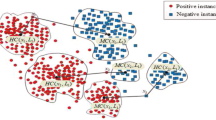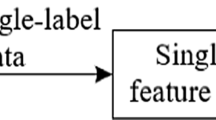Abstract
Multi-label learning deals with data in which an instance may belong to multiple class labels simultaneously. Due to the increasing applications of multi-label data, especially in text and image classification problems, multi-label feature selection has attracted much attention in recent years. The main problem of the existing multi-label feature selection algorithms is that they are not able to consider all possible subsets of feature space in evaluating a candidate feature, because of computational concerns. Therefore they ignore much of the useful higher-order information, hidden in larger subsets. This paper proposes a new approach to address the higher-order relevance and redundancy analysis. The proposed method generates an adjacency matrix using pairwise features relevance and redundancy then uses the geometric series of the matrix as a part of the evaluation function. In this way it is able to consider all possible subsets of feature space in evaluating a single candidate feature. Experimental results on five benchmarks from different domains clearly demonstrate the superiority of the proposed method against seven state-of-the-art multi-label feature selection algorithms. The codes are available at https://github.com/Sadegh28/Inf-MLFS.





Similar content being viewed by others
References
Bidgoli AA, Ebrahimpour-Komleh H, Rahnamayan S (2021) Reference-point-based multi-objective optimization algorithm with opposition-based voting scheme for multi-label feature selection. Inf Sci 547:1–17
Boutell MR, Luo J, Shen X, Brown CM (2004) Learning multi-label scene classification. Pattern Recogn 37(9):1757–1771
Briggs F, Huang Y, Raich R, Eftaxias K, Lei Z, Cukierski W, Hadley SF, Hadley A, Betts M, Fern XZ, et al (2013) The 9th annual mlsp competition: New methods for acoustic classification of multiple simultaneous bird species in a noisy environment. In 2013 IEEE International Workshop on Machine Learning for Signal Processing (MLSP), pages 1–8. IEEE
Chandrashekar G, Sahin F (2014) A survey on feature selection methods. Comput Electr Eng 40(1):16–28
Cover TM, Thomas JA (2006) Elements of Information Theory (Wiley Series in Telecommunications and Signal Processing). Wiley-Interscience, USA
Dionisio A, Menezes R, Mendes DA (2004) Mutual information: a measure of dependency for nonlinear time series. Phys A 344(1–2):326–329
Diplaris S, Tsoumakas G, Mitkas PA, Vlahavas I (2005) Protein classification with multiple algorithms. In: Panhellenic Conference on Informatics, pages 448–456. Springer
Doquire G, Verleysen M (2011) Feature selection for multi-label classification problems. In: International Work-Conference on Artificial Neural Networks, pages 9–16. Springer
Dumais ST (2004) Latent semantic analysis. Ann Rev Inf Sci Technol 38(1):188–230
Eskandari S (2022) Pyit-mlfs: a python-based information theoretical multi-label feature selection library. International Journal of Research in Industrial Engineering
Gharroudi O, Elghazel H, Aussem A (2014) A comparison of multi-label feature selection methods using the random forest paradigm. In: Canadian Conference on Artificial Intelligence, pages 95–106. Springer
Gretton A, Bousquet O, Smola A, Schölkopf B (2005) Measuring statistical dependence with hilbert-schmidt norms. In: International Conference on Algorithmic Learning Theory, pages 63–77. Springer
Gu Q, Li Z, Han J (2011) Correlated multi-label feature selection. In: Proceedings of the 20th ACM International Conference on Information and Knowledge Management, pages 1087–1096
Guyon I, Elisseeff A (2003) An introduction to variable and feature selection. J Mach Learn Res 3:1157–1182
Hashemi A, Dowlatshahi MB, Nezamabadi-pour H (2020) Mfs-mcdm: Multi-label feature selection using multi-criteria decision making. Knowl-Based Syst 206:106365
He Z, Yu W (2010) Stable feature selection for biomarker discovery. Comput Biol Chem 34(4):215–225
Hong R, Wang M, Gao Y, Tao D, Li X, Wu X (2013) Image annotation by multiple-instance learning with discriminative feature mapping and selection. IEEE Trans Cybern 44(5):669–680
Hu L, Li Y, Gao W, Zhang P, Hu J (2020) Multi-label feature selection with shared common mode. Pattern Recogn 104:107344
Huang J, Li G, Huang Q, Wu X (2017) Joint feature selection and classification for multilabel learning. IEEE Trans Cybern 48(3):876–889
Hubbard JH, Hubbard BB (2015) Vector calculus, linear algebra, and differential forms: a unified approach. Matrix Editions
Jian L, Li J, Shu K, Liu H (2016) Multi-label informed feature selection. In IJCAI 16:1627–33
Kashef S, Nezamabadi-pour H, Nikpour B (2018) Multilabel feature selection: a comprehensive review and guiding experiments. Wiley Interdiscip Rev Data Min Knowl Dis 8(2):e1240
Khinchin AY (2013) Mathematical foundations of information theory. Courier Corporation
Lee J, Kim D-W (2013) Feature selection for multi-label classification using multivariate mutual information. Pattern Recogn Lett 34(3):349–357
Lee J, Kim D-W (2015) Mutual information-based multi-label feature selection using interaction information. Expert Syst Appl 42(4):2013–2025
Lee J, Kim D-W (2017) Scls: multi-label feature selection based on scalable criterion for large label set. Pattern Recogn 66:342–352
Li L, Liu H, Ma Z, Mo Y, Duan Z, Zhou J, Zhao J (2014) Multi-label feature selection via information gain. In International Conference on Advanced Data Mining and Applications, pages 345–355. Springer
Lin Y, Hu Q, Liu J, Duan J (2015) Multi-label feature selection based on max-dependency and min-redundancy. Neurocomputing 168:92–103
Liu SM, Chen J-H (2015) A multi-label classification based approach for sentiment classification. Expert Syst Appl 42(3):1083–1093
Lv S, Shi S, Wang H, Li F (2021) Semi-supervised multi-label feature selection with adaptive structure learning and manifold learning. Knowl-Based Syst 214:106757
Nguyen BH, Xue B, Zhang M (2020) A survey on swarm intelligence approaches to feature selection in data mining. Swarm Evol Comput 54:100663
Pedregosa F, Varoquaux G, Gramfort A, Michel V, Thirion B, Grisel O, Blondel M, Prettenhofer P, Weiss R, Dubourg V et al (2011) Scikit-learn: machine learning in python. J Mach Learn Res 12:2825–2830
Peng H, Long F, Ding C (2005) Feature selection based on mutual information criteria of max-dependency, max-relevance, and min-redundancy. IEEE Trans Pattern Anal Mach Intell 27(8):1226–1238
Pereira RB, Plastino A, Zadrozny B, Merschmann LH (2018) Categorizing feature selection methods for multi-label classification. Artif Intell Rev 49(1):57–78
Pestian J, Brew C, Matykiewicz P, Hovermale DJ, Johnson N, Cohen KB, Duch W (2007) A shared task involving multi-label classification of clinical free text. In: Biological, translational, and clinical language processing, pages 97–104
Qian W, Huang J, Wang Y, Xie Y (2021) Label distribution feature selection for multi-label classification with rough set. Int J Approx Reason 128:32–55
Read J (2008) A pruned problem transformation method for multi-label classification. In: Proc. 2008 New Zealand Computer Science Research Student Conference (NZCSRS 2008), volume 143150, page 41
Roffo G, Melzi S, Cristani M (2015) Infinite feature selection. In: Proceedings of the IEEE International Conference on Computer Vision, pages 4202–4210
Shao H, Li G, Liu G, Wang Y (2013) Symptom selection for multi-label data of inquiry diagnosis in traditional chinese medicine. Sci China Inf Sci 56(5):1–13
Spolaôr N, Cherman EA, Monard MC, Lee HD (2013) A comparison of multi-label feature selection methods using the problem transformation approach. Electron Notes Theor Comput Sci 292:135–151
Spolaôr N, Monard MC, Tsoumakas G, Lee HD (2016) A systematic review of multi-label feature selection and a new method based on label construction. Neurocomputing 180:3–15
Szymański P, Kajdanowicz T (2017) A scikit-based python environment for performing multi-label classification. arXiv preprint arXiv:1702.01460
Trohidis K, Tsoumakas G, Kalliris G, Vlahavas IP et al (2008) Multi-label classification of music into emotions. In ISMIR 8:325–330
Tsoumakas G, Spyromitros-Xioufis E, Vilcek J, Vlahavas I (2011) Mulan: a java library for multi-label learning. J Mach Learn Res 12:2411–2414
Tsoumakas G, Vlahavas I (2007) Random k-labelsets: An ensemble method for multilabel classification. In: European Conference on Machine Learning, pages 406–417. Springer
Vergara JR, Estévez PA (2014) A review of feature selection methods based on mutual information. Neural Comput Appl 24(1):175–186
Yang Y-H, Chen HH (2012) Machine recognition of music emotion: a review. ACM Trans Intel Syst Technol (TIST) 3(3):1–30
Yu K, Yu S, Tresp V (2005) Multi-label informed latent semantic indexing. In: Proceedings of the 28th annual international ACM SIGIR conference on Research and development in information retrieval, pages 258–265
Zhang M-L, Peña JM, Robles V (2009) Feature selection for multi-label naive bayes classification. Inf Sci 179(19):3218–3229
Zhang P, Gao W, Hu J, Li Y (2021) Multi-label feature selection based on the division of label topics. Inf Sci 553:129–153
Zhang P, Liu G, Gao W (2019) Distinguishing two types of labels for multi-label feature selection. Pattern Recogn 95:72–82
Zhang P, Liu G, Gao W, Song J (2021) Multi-label feature selection considering label supplementation. Pattern Recogn 120:108137
Zhang Y, Zhou Z-H (2010) Multilabel dimensionality reduction via dependence maximization. ACM Trans Knowl Discov Data (TKDD) 4(3):1–21
Author information
Authors and Affiliations
Corresponding author
Additional information
Publisher's Note
Springer Nature remains neutral with regard to jurisdictional claims in published maps and institutional affiliations.
Rights and permissions
About this article
Cite this article
Eskandari, S. Multi-label feature selection using geometric series of relevance matrix. J Supercomput 78, 14402–14418 (2022). https://doi.org/10.1007/s11227-022-04451-1
Accepted:
Published:
Issue Date:
DOI: https://doi.org/10.1007/s11227-022-04451-1




